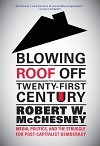Movements
Many people think of cooperatives as small, locally owned businesses, such as groceries, cafes, or bicycle shops, where people can work in an equal and participatory non-capitalist organization. In reality, the U.S. co-op movement is tied to federal agencies whose agenda is promoting neoliberalism, both domestically and abroad, and the co-op movement itself has neoliberal leaders. Many co-ops in name are profit-driven capitalist corporations in practice. And even in the abstract, the co-op principles of smaller co-ops enable neoliberal cooperative politics. All of this, however, raises the question of what a co-op based on socialist values would be, and China’s Nanjie village provides a living example of that. | more…
Three years after the fact, the event called Occupy retains its strange strategic inconsistency. It is something we still do not know how to think about.… We should take this illegibility seriously, not only as a tactical decision, but also as a reflection of the inadequacy of our inherited categories in describing the current logic of class struggle. This inadequacy should not surprise us; on the contrary, it confirms the ongoing vitality of the real movement to abolish the state of our present situation. Approaching Occupy requires that we separate out what happened from what was said about what happened, and place both in political-economic context. In what follows I briefly consider the first and third of these, and hope to address the second in the near future. | more…
Our friend and comrade Pete Seeger died a year ago this month, on January 27, 2014. Pete was a long-time reader of Monthly Review and, occasionally, a writer for this magazine. Harry Magdoff used to say that when a letter arrived from Pete, nearly always handwritten and often pages long, responding to an article or suggesting a topic to be covered or a book to be reviewed, it would go right home with him, to be pondered, considered, answered, and, especially, enjoyed. Seeger’s communications were never innocuous: he would tell the editors that something MR had published was wrongheaded (or, sometimes, right-headed); he would take an idea, turn it over, and suggest where to go with it. Like his music, Seeger’s letters demanded engagement, participation—and action. He had a special place in the MR family. | more…
In the many accolades Pete Seeger received…after his death, there was often something missing—as absent in tributes from admirers who share his revolutionary politics as in those aiming to reclaim him for respectability. That absence is Seeger’s role as an organizer, and, more broadly, the role of music (and other kinds of cultural work) as organizing, which his life exemplifies.… Seeger’s work as an organizer may have been most obvious, its goals most blatant, in the field…. But his work, as a singer, as a song-collector, as a song-teacher, was not any less a labor of organizing in the concert hall. And that’s not exceptional. That…is what makes someone a radical cultural worker. What’s exemplary about Pete Seeger is how damn good at it he was. What we need to pay attention to and learn from is how he did this important work so well. | more…
In the late 1950s, Pete Seeger received a letter from his manager, Howie Richmond, begging him to write a new hit song. … [Richmond] believed that “protest songs” were not marketable. Seeger was angry—he had a new song in mind, with words from a poem that he had set to music, and he believed it was, in a deep and significant sense, a song of protest.…. The song, of course, was “Turn! Turn! Turn! (To Everything There Is a Season),” which continues to be performed and recorded by many artists, and most famously became a huge folk-rock hit for The Byrds. It was as though, despite himself, Seeger produced a hit song, even when commercial popularity was the furthest thing from his mind—an example of how inseparably his songwriting talents and political principles were bound together. | more…
Getting from Here to There
Pete Seeger is an environmental advocate who understands the transforming power of immersion in nature. However, his desire to restore his cherished Hudson River posed a monumental challenge in the 1960s. The Hudson River, once so majestic that it inspired the Hudson River School painters, had become a sewer for the communities and commercial industries that populated its shoreline. Seeger’s approach to reversing the degradation of the Hudson River involved a unique form of advocacy and organizing. He envisioned healing the Hudson through immersion. His approach involved bringing people back to the river aboard a 106-foot replica of a Hudson River sloop (a single-masted sailboat), one that resembled the boats that traversed the Hudson in centuries past. By 1969, with Seeger as the driving force behind its creation, the sloop Clearwater was constructed and launched. It still sails today and serves as an inspiring symbol of citizen activism on behalf of the natural environment. | more…
Contradictions of the Digital Economy
We have now entered a period…when new waves of commodification set in motion in earlier periods are reaching maturity. The new commodities have been generated by drawing into the market even more aspects of life that were previously outside the money economy, or at least that part of it that generates a profit for capitalists. Several such fields of accumulation have now emerged, each with a different method of commodity genesis, forming the basis of new economic sectors and exerting distinctive impacts on daily life, including labor and consumption. They include biology, art and culture, public services, and sociality. | more…

Ursula Huws ties together disparate economic, cultural, and political phenomena of the last few decades to form a provocative narrative about the shape of the global capitalist economy at present. She examines the way that advanced information and communications technology has opened up new fields of capital accumulation: in culture and the arts, in the privatization of public services, and in the commodification of human sociality by way of mobile devices and social networking. These trends are in turn accompanied by the dramatic restructuring of work arrangements, opening the way for new contradictions and new forms of labor solidarity and struggle around the planet. | more…

In the United States and much of the world there is a palpable depression about the prospect of overcoming the downward spiral created by the tyranny of wealth and privilege and establishing a truly democratic and sustainable society. It threatens to become self-fulfilling. In this trailblazing new book, award-winning author Robert W. McChesney argues that the weight of the present is blinding people to the changing nature and the tremendous possibilities of the historical moment we inhabit. In Blowing the Roof Off the Twenty-First Century, he uses a sophisticated political economic analysis to delineate the recent trajectory of capitalism and its ongoing degeneration. | more…

On September 20, 2014, while corporate and government officials arrived in New York City for the UN Climate Summit, organizers and activists from around the world participated in a peoples’ summit called the NYC Climate Convergence (organized by the Global Climate Convergence and System Change Not Climate Change). The NYC Climate Convergence featured as the lead keynote speaker Naomi Klein, who presented the analysis of her new book, This Changes Everything: Capitalism vs. the Climate (Simon and Schuster, 2014). Her concluding chapter, significantly, is entitled “Leap Years: Just Enough Time for the Impossible.” Monthly Review readers will be interested that Klein observes in her book: “Karl Marx… recognized capitalism’s ‘irreparable rift’ with the ‘natural laws of life itself’”. Later she refers to “global capitalism’s voracious metabolism”. | more…
Braverman and the Structure of the U.S. Working Class
Harry Braverman’s Labor and Monopoly Capital, first published forty years ago in 1974, was unquestionably the work that, in the words of historian Bryan Palmer, “literally christened the emerging field of labor process studies.” In the four decades since its appearance Braverman’s book has continued to play a central role in debates on workers’ struggles within industry, remaining indispensable to all attempts at in-depth critique in this area.… This continuing relevance of Braverman’s analysis has to do with the fact that his overall vision of the transformations taking place in modern work relations was much wider than has usually been recognized. Viewed from a wide camera angle, his work sought to capture the complex relation between the labor process on the one hand, and the changing structure and composition of the working class and its reserve armies on the other. This broad view allowed him to perceive how the changes in the labor process were integrally connected to the emergence of whole new spheres of production, the decomposition and recomposition of the working class in various sectors, and the development of new structural contradictions. | more…
Ervand Abrahamian, The Coup: 1953, the CIA, and the Roots of Modern U.S.-Iranian Relations (New York: New Press, 2012), 304 pages, $26.95, hardback.
The Cold War between the Soviet Union and the United States began in earnest as soon as the Second World War ended, shaping most of the remainder of the twentieth century. The U.S. doctrine of “containment” required confronting the Soviets at every point of contact, accompanied by the claim that lasting peace could be reached only through the establishment of an international order based on national states which enjoyed a U.S.-defined political liberty and a capitalist economic order. The Soviets bolstered their security through providing support to countries seen as friendly and close to their borders. Therefore, maintaining influence in Iran was a goal of Soviet foreign policy in the Middle East. U.S. foreign policy was shaped by its own state interests and ideology and driven by the American postwar, worldwide systems of military bases.… It is this turbulent period of geopolitical maneuvering that Ervand Abrahamian’s The Coup revisits. Yet, unlike other books on the 1953 events in Iran, Abrahamian locates the U.S.-backed coup less in the Cold War ideological confrontation between East and West than in the conflicts which opposed imperialism and nationalism; between the center of world capitalism and the underdeveloped economies heavily dependent on exporting raw natural resources. | more…


